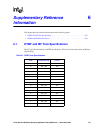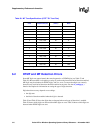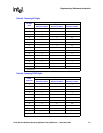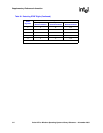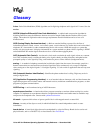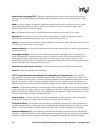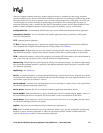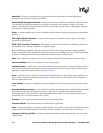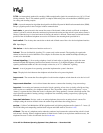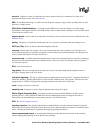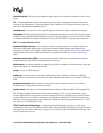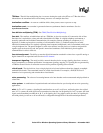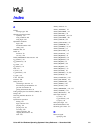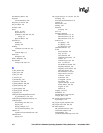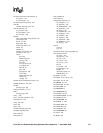
546 Voice API for Windows Operating Systems Library Reference — November 2003
download: The process where board level program instructions and routines are loaded during board
initialization to a reserved section of shared RAM.
downloadable Springware firmware: Software features loaded to Intel® voice hardware. Features include
voice recording and playback, enhanced voice coding, tone detection, tone generation, dialing, call progress
analysis, voice detection, answering machine detection, speed control, volume control, ADSI support, automatic
gain control, and silence detection.
driver: A software module which provides a defined interface between an application program and the firmware
interface.
DSP (Digital Signal Processor): A specialized microprocessor designed to perform speedy and complex
operations on digital signals.
DTMF (Dual-Tone Multi-Frequency): Push-button or touch-tone dialing based on transmitting a high- and a
low-frequency tone to identify each digit on a telephone keypad.
E-1: A CEPT digital telephony format devised by the CCITT, used in Europe and other countries around the
world. A digital transmission channel that carries data at the rate of 2.048 Mbps (DS-1 level). CEPT stands for the
Conference of European Postal and Telecommunication Administrations. Contrast with T-1.
echo: The component of an analog device’s receive signal reflected into the analog device’s transmit signal.
echo cancellation: Removal of echo from an echo-carrying signal.
emulated device: A virtual device whose software interface mimics the interface of a particular physical device,
such as a D/4x boards that is emulated by a D/12x board. On a functional level, a D/12x board is perceived by an
application as three D/4x boards. Contrast with physical device.
event: An unsolicited or asynchronous message from a hardware device to an operating system, application, or
driver. Events are generally attention-getting messages, allowing a process to know when a task is complete or
when an external event occurs.
event handler: A portion of an application program designed to trap and control processing of device-specific
events.
extended attribute functions: A class of functions that take one input parameter (a valid Intel® device handle)
and return device-specific information. For instance, a voice device’s extended attribute function returns
information specific to the voice devices. Extended attribute function names are case-sensitive and must be in
capital letters. See also standard runtime library (SRL).
firmware: A set of program instructions that reside on an expansion board.
firmware load file: The firmware file that is downloaded to a voice board.
flash: A signal generated by a momentary on-hook condition. This signal is used by the voice hardware to alert a
telephone switch that special instructions will follow. It usually initiates a call transfer. See also hook state.
frequency shift keying (FSK): A frequency modulation technique used to send digital data over voice band
telephone lines.




